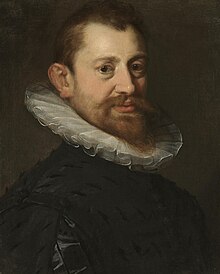Adriaen de Vries
Adriaen de Vries | |
|---|---|
 Portrait by Hans von Aachen | |
| Born | Circa 1556 |
| Died | 1626 |
| Known for | Sculpting |
| Style | Northern Mannerism |
Adriaen de Vries (c.1556–1626) was a
Partly as a result of the disturbances of the Thirty Years' War, and also changes in style, Adriaen de Vries had no direct follower.
Life
Born in The Hague to a patrician family,[1] his early training is obscure; a recent suggestion[2] suggests an apprenticeship with Willem Danielsz. van Tetrode, known in Italy as Guglielmo Fiammingo, a pupil of Benvenuto Cellini who had returned to the Netherlands. Another possibility is that he was apprenticed to a goldsmith, his brother-in-law Simon Adriaensz Rottermont. Both possibilities are suggestive in view of de Vries' virtuoso casting technique and refined finish.
Apprenticeship in Italy
He travelled to
Commissions in Savoy and Germany
This led to his brief appointment as court sculptor to Philip II's son-in-law
Return to Bohemia (after 1601)
De Vries returned in 1601 to Prague, where Rudolf made him Kammerbildhauer ("chamber sculptor", i.e. privileged artist). During his hypothetical stay in Rome in 1604, he had cast a statue of Christ at the column, a centrepiece for Adam von Hannewaldt's tomb monument in the Holy Trinity Church in Rothsürben (
During this late period he found a new patron in the Prince
Works
The Rijksmuseum owns the only two sculptures by de Vries found in his native Netherlands, a bronze relief of Bacchus and Ariadne, and the recently purchased (2014) Bacchant. The artist was scarcely known there until the exhibition mounted by the Rijksmuseum, the Nationalmuseum, Stockholm, and the J. Paul Getty Museum in 1999.
Gallery
-
Hercules fountain, gardens of Drottningholm Palace
-
Wrestlers, in garden at Drottningholm Palace
-
Apollo, c. 1594, Metropolitan Museum of Art
-
Mercury and Psyche, 1593,Musée du Louvre
-
Bust of Emperor Rudolf II, 1607, Imperial Treasury, Vienna
-
Empire Triumphant over Avarice, 1610, National Gallery of Art, Washington D.C.
-
Resurrection monument (a cenotaph) in the Prince Ernst of Schaumburg's mausoleum, 1613–1620
-
De Vries' reinterpretation of the Laocoön theme (1623), bronze replica in the Wallenstein Palace gardens, Prague
Notes
- ^ His father, an apothecary, held several distinguished civic positions.
- ^ Frits Scholten, Adriaen de Vries 1556-1626: Imperial Sculptor (Zwolle: Waanders) 1999.
- ^ Though the chapel was dismantled by the Napoleonic government, the sculptures have been preserved at the University of Genoa; Michael Bury, "The Grimaldi Chapel of Giambologna in San Francesco di Castelletto, Genoa," MKIF 26 (1982) pp 85-127.
- ^ a b Łoś, Władysław (1981). "Christ at the Column" by Adrian de Vries: from the Hannewaldt Memorial at Żórawina. Bulletin du Musée National de Varsovie. pp. 27, 31.
- ^ Remarked by Manfred Leithe-Jasper in reviewing the exhibition in The Burlington Magazine 141 No. 1155 (June 1999), pp. 372-375.
- ^ "Museum de Vries - Sveriges Kungahus". Archived from the original on 2011-12-28. Retrieved 2012-03-09.
Further reading
- Scholten, Frits. Adriaen de Vries 1556-1626: Imperial Sculptor (Zwolle: Waanders) 1999.








